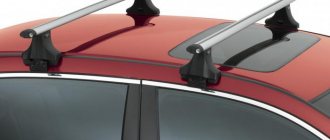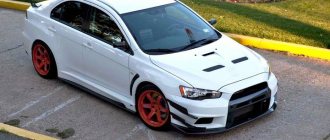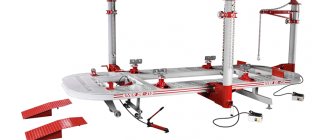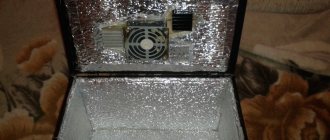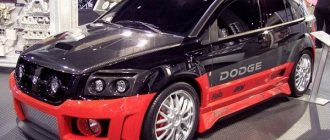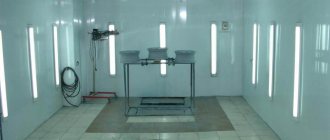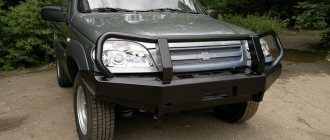I was tired of my original springs due to their stiffness, so I decided to replace them. They stood like this: height
25 cm, coil diameter 19mm. constant coil
600 kg, the rear sank and the arches almost lay on the rubber. Plus, I didn’t have rubber spacers for the springs. I found a piece of conveyor belt and decided to buy some spacers and raise them at the same time.
Do-it-yourself spacers for increasing ground clearance are a kind of tuning and the ability to change the ground clearance of the car to overcome barriers along the route and improve cross-country ability.
Material characteristics
This model is a cylinder shape that is mounted under shock absorbers and suspension springs. Different materials of manufacture, density and dimensions of spacers for increasing ground clearance are determined by the purpose of installation on the front or rear of the car body. As a rule, the choice of one spacer or another does not depend on the make of the car: most parts are universal.
The material used to make parts can be divided into metal (steel or aluminum) and non-metal (polyurethane, plastic). Metal spacers are mounted under the spring, and non-metal spacers are mounted above the spring.
To have a clear idea of the subject, you can watch the installation of a spacer to increase ground clearance with your own hands in the video.
What you need to know when installing or replacing spacers
To ensure safety at the work site, wheel chocks will be needed to prevent the vehicle from moving, putting people at risk. It is mandatory to fix the jack in a vertical position without any deviation at an angle to prevent the machine from falling. Other safety rules that must be followed include:
- never do work alone. There should be at least one person who can help with the individual steps of disassembling the vehicle and putting parts back into place. For example, one person simply cannot cope with removing a spring, but a second or even third person will always hold the car and help pull out the necessary unit;
- When performing work outdoors after precipitation, it is better to place a board or other solid object under the jack. The best option is to carry out all work on a hard and level surface such as concrete or asphalt;
- there should be a first aid kit nearby (including the car itself) to provide immediate assistance;
- When placing the vehicle on a jack, be sure to put it in first gear and turn on the handbrake - this eliminates the risk of wheel movement;
- Before climbing under the car, after installing the jack, you need to check the stability by rocking from side to side. If the car has not fallen, work can begin.
It is not recommended to use homemade spacers, as they are most often made with a gross violation of technology. Similarly, the use of “refurbished” products is unacceptable. Before changing the clearance, you will need to measure its value so that there is not too much difference from the passport parameters. Increasing the distance between the bottom and the road cannot improve driving performance if the vehicle was not originally designed for off-road use.
There is a small legislative aspect: when insuring a vehicle, exactly the factory parameters are indicated, from which you cannot deviate, since in the event of an insured event, a refusal may occur due to a deliberate departure from the factory settings by changing the parameters of the car. You can increase the ground clearance using spacers to ensure comfortable driving conditions on an existing car.
Installing spacers to increase ground clearance: front, rear - step-by-step instructions with photos and videos
3.5 (70%) 2 votes
What is it for?
There are two reasons for raising the vehicle's ground clearance:
- off-road driving;
- sagging of springs over time.
To restore the spring to its original position, special spacers are used. The ideal option would be to replace old springs with new ones at a service station; however, car owners widely practice installing spacers to increase ground clearance with their own hands. If previously, increasing ground clearance was achieved by introducing tennis balls into the springs, now car dealerships sell special spacers of various thicknesses.
Pros and cons of the clearance operation
Is there really a need to tune the suspension, and will such a change damage the car? Before installing aluminum spacers under the springs, let’s pay attention to the positive aspects of the changes:
- protection of the rear suspension, underbody and crankcase from breakdowns;
- protection of the rear wheels from impacts on the fender liner;
- increasing the vehicle's off-road capability.
The disadvantages of installing a spacer under the springs with your own hands include:
- failure of the lower shock absorber mounting;
- additional load on the bottom bracket;
- car instability on an icy surface;
- impairment of vehicle controllability due to a shift in the center of gravity;
- rapid wear of steering parts;
- imbalance of wheel alignment.
After tuning, the car owner needs to pay more attention to the suspension in general and shock absorbers in particular.
Summarize
I cannot advise or dissuade you from installing spacers. Much depends on the specific car, its condition, driving style, operating conditions, and so on.
The reason to refuse spacers may be the fact that after their installation the levers are lowered and are constantly in this state. As a result, the geometry is disrupted, the suspension system works differently, and changes for the worse, the previous sensitivity of the steering is lost, and the car can skid at high speeds.
Spacers also increase the load on the suspension itself; silent blocks, shock absorbers, and steering rods wear out.
It's up to you to decide. Think about where to buy spacers and whether it is worth buying them specifically in your case. It may be easier to change the wheels or the springs themselves. It's more expensive, but safer.
Share your impressions if you have used spacers. Don't forget to leave comments, invite your friends and tell everyone you know about us. This is not difficult for you, but we are incredibly pleased!
(
20 ratings, average: 4.50 out of 5)
What to choose?
What are spacers made of to increase ground clearance? The choice of material depends on the design of your machine. In the front compartment of the car, spacers made of metals are mounted: steel or aluminum alloys. It is recommended to place rubber or plastic products under the rear springs.
Which spacers are best for increasing ground clearance? Firstly, you cannot install any spacers over 30 mm thick. Secondly, polyurethane products can cause damage to the body by steel bushings due to rapid wear.
Aluminum products are the most reliable, although they cause corrosion at points of contact with the body. In practice, plastic spacers have shown themselves to work well to increase ground clearance, without revealing any serious shortcomings. Rubber material is the cheapest, but is prone to tearing, deformation and rapid wear.
About the body and suspension lift
Other springs
This method is used most often by car enthusiasts, since it can be figured out even without using an Internet search. Increasing ground clearance using this method is not difficult, but if you do not have a particularly popular car, then you will have a very difficult time finding springs.
This method has a lot of disadvantages. Firstly, you will not find such a spare part from the manufacturer, that is, you cannot be sure of the quality of the spring and the materials from which it is made. Secondly, handling suffers greatly, with increased roll and poor stabilization on the highway.
This is very easy to do, you buy new springs and install them. It is difficult to discuss the cost, since the amounts depend on the manufacturer and the specific model. As a result, you will get plus 6-12 centimeters. But such increases will have a very bad effect on your driving safety.
Installation Rules
To properly make spacers for springs with your own hands, you need to take into account some nuances:
- Setting the ground clearance above 30 mm leads to wheel alignment problems.
- It is not recommended to install metal products that have not been pre-treated against corrosion.
- It is recommended to raise the front of the body by no more than 20 mm.
- The rear compartment of the body is raised by no more than 30 mm.
- If the shock absorber is not located next to the spring, spacers should be mounted under the springs and shock absorbers to balance the structure.
DIY front suspension upgrade
The procedure for replacing springs and adding spacers is divided into several stages:
- Preparation of tools.
- Disassembling the suspension with removing the front strut.
- Selection and purchase of parts for tuning.
- Installation of springs and spacers, reassembly.
- Correction of camber angles - wheel toe-in.
If you purchased a car second-hand, it is recommended that you follow this sequence. You should not purchase parts without disassembling the suspension mechanism and seeing what is currently there. The previous owner of the car could also have added body-raising elements so as not to have to change the sagging springs, then the pre-purchased parts will be unnecessary and you will waste your money.
Standard spacers under the springs are about 2 cm high
It’s another matter when the car was purchased at a showroom and you know that there was no outside interference in the design. Then buy a set of spacers in advance.
What tool do you need to make high ground clearance?
Among the special devices, you will need a puller designed for squeezing out the ball pins of the steering rods, and spring ties in the form of pins with grips. Both are sold for little money and will be quite useful in the future if you are used to repairing your car with your own hands. The list of other tools looks like this:
- a set of open-end wrenches and sockets with a handle equipped with a ratchet;
- wheel wrench and jack for removing wheels;
- wheel chocks;
- ordinary plumbing tools - a hammer, various screwdrivers, bronze attachments and pliers;
- cloth gloves and rags.
Types of pullers for pressing out ball pins
Advice. Do not ignore gloves and work with bare hands when disassembling the chassis of a car. It’s not scary to get them dirty with dirt and grease; it’s much more unpleasant to knock your hands loose when loosening the nuts and breaking off the keys.
Spring compression ties
Disassembly procedure
First of all, place stands under the rear wheels of the car, open the hood and install a jack. Then unscrew and remove one of the front wheels, and then proceed according to the following algorithm:
- Loosen the nuts securing the upper part of the shock absorber, located in a circle from the protruding rod (usually 3 pieces), but do not unscrew them completely. If the latter is covered with a protective cap, remove it.
- Holding the rod by the edges at the end, unscrew the main nut holding it to the glass.
- Disassemble the mounting assembly of the strut to the steering knuckle by unscrewing the nuts and knocking out the bolts through the bronze adapter.
- Unscrew the nut holding the tie rod ball pin, having first pulled out the locking pin (if there is one). Put on the puller and press the rod end out of the socket.
- The stand is now hanging by the 3 top nuts that you loosened initially. Unscrew them and pull out the entire assembly.
First of all, unscrew the bolts of the upper strut support
Note. If a tube with brake fluid is attached to the rack, as is done on Russian front-wheel drive VAZs, then it also needs to be carefully disconnected and moved to the side.
After dismantling, all that remains is to release the spring, to do this, compress it with ties and unscrew the nut holding the support bearing. After this, remove the spring with the standard fittings to take it with you to the store for comparison with the new parts.
To disassemble the unit, you need to tighten the spring
If the front suspension design of your car is multi-link, then the disassembly algorithm changes. There is no need to press out the tie rod end; the first step is to unscrew the lower shock absorber mount. Then proceed like this:
- Place a wooden block or other support under the lower arm and lower the jack.
- Unscrew the pin of the lower ball joint and press it out of the eye on the hub with a puller. Raise the jack if necessary.
- Disconnect the end of the anti-roll bar from the lower arm.
- Use zip ties to compress the spring, lift the jack and pull it out of the glass. From there, remove the standard spacer.
Front suspension diagram with 2 arms
Photo of front suspension disassembly
The ball pin is squeezed out with a puller
The stand is removed along with the spring
Steering rod ball pin nut
After unscrewing the lower bolts, the hub is separated from the rack
The upper fastening nut must be twisted while holding the rod
At the bottom the stand is held on by 2 bolts
Selecting elements for lifting a car
As a rule, to increase ground clearance, repair springs are selected whose height is 1 turn greater. This will give an increase in ground clearance of 3-5 cm, which is quite enough for a passenger car. There are other options:
- choose springs of increased rigidity so that the machine does not “sit down” when loading, plus spacers 30 mm high;
- buy a set of spacers along with reinforced upper supports;
- use a standard spring with interturn and lifting spacers.
Rubber spacer kit
You can use each option individually or in combination, the main thing is not to go beyond 50 mm. And for some cars, whose clearance above the road is already quite good, a rise of 30 mm is enough. The spacers themselves are made from the following materials:
- Rubber parts are low in price, but their service life is limited, so the attachments will have to be changed periodically.
- Polyurethane products are stronger than rubber ones, but they are also more expensive.
- Lightweight aluminum spacers are practically eternal, they will last for the entire service life of the car.
Polyurethane inserts
Important point. Along with the spring reinforcement elements, do not forget to purchase devices for lengthening the shock absorbers, otherwise their working stroke will not be enough to dampen vibrations of the raised body. Constantly being in the extreme open position, the rod breaks the upper part of the shock absorber body, causing the latter to fail.
Aluminum spacers
How to increase: installation of new parts and assembly
To install the elements that you purchased to increase the vehicle's ground clearance, you need to proceed in the reverse order. Move the ties to the new spring, compress it and assemble the rack, installing reinforced spacers instead of the standard ones. If necessary, install devices to extend the shock absorbers. Try to insert the parts into their places clearly and without distortions, so that the height of the body above the ground remains the same at different points and there are no creaks from rubber bands that are incorrectly rotated in the sockets.
Assembling the front strut with spacers
Advice. Before installation, tighten the new spring with tools, focusing on the length of the old element. Then she will freely fall into place.
Assembly with aluminum extension
Taking this moment while the assembly is disassembled, check the technical condition of the remaining parts - bearings, rubber bushings and ball joint pins or tie rod ends. It is recommended to lubricate the upper support bearing of the strut before installation. There are no tricks here, just reassemble the car in reverse order. When finished, be sure to visit a service station and adjust the camber, otherwise lateral wear of the ramps is inevitable.
Using spacers - video
Front installation procedure
How to install spacers to increase ground clearance in the front part of the body? To do this, follow the recommendations:
- We lift the car with a jack, remove the tire, disconnect the braking system and the stabilizer link.
- We install other bolts of the required size on the rack (the old ones do not fit in length).
- We fix the spacer to the bolt and assemble the entire structure to its original state.
For greater clarity, you can see the diagram for installing a spacer to increase ground clearance with your own hands in the drawings.
Rear installation procedure:
- We disconnect the thresholds under the loading compartment lid and the rear door area.
- Move back the rear seats.
- We remove the panels and leave one body.
- We remove the wheel.
- We install the bolts according to the example of the front part of the body.
- We assemble the structure in reverse order.
If the word “jack” causes you vague anxiety, and the idea of the location of the bolts seems unclear, watch the procedure for installing a spacer under the springs in the video.
When creating a car, design engineers calculate every millimeter, establishing a certain balance between the parts and assemblies of the vehicle. Any change made to the design of a car in order to improve technical characteristics introduces a certain imbalance into the overall structure.
It is not always possible to increase the cross-country ability of a car designed to drive on asphalt. No matter how hard you try to change or improve the condition of the suspension using various manipulations, you will not be able to improve the design to the condition of an SUV. Either buy an SUV, or resign yourself to driving on city highways.
The quality of domestic roads is very far from ideal. Potholes, bumps and cracks have long accompanied us when driving in almost all regions. There is nothing to say about dirt roads. The car's suspension is designed to compensate for wheel vibrations when driving through potholes. But, unfortunately, its power reserve is not always enough to avoid hitting the bottom with the road. The solution can be to increase ground clearance - the distance between the lowest point of the car and the road surface. This can be done using special spacers for springs. We'll talk about them today.
Spacer
Car springs have a certain distance between each turn; in this place you can insert a rubber gasket that is thicker than this distance. Such a gasket can be purchased at the store. As a result, after installation the car will sag less from its own weight. That is, the spring is initially compressed due to the fact that the body itself presses on it, and the gasket makes this compression less.
Where this spacer is installed, there will be practically no compression, and where it is not there, the compression will be greater. But despite this, most inexpensive cars, such as Ford Focus, Hyundai Solaris and so on, receive 3-5 cm to the previous ground clearance. Yes, you can install even more of these spacers and get an even greater increase, but it’s better not to do this.
This method will give you what you need, but there is a downside. Spacers will greatly increase rigidity, especially if your car is not particularly comfortable to begin with. Controllability will also deteriorate and ESP will not work as correctly as before.
All this is not particularly expensive, and you can do the whole procedure yourself. If you buy it for AvtoVAZ models, then on average they will cost you 500 rubles a set. If you don’t have a particularly expensive foreign car, then at least you will need 2,000 rubles for a set.
What it is
Spacers are special devices that reduce the compression stroke of a car's suspension springs or lift the car body above the shock absorber strut. Spacers are also installed between the body and the frame (if any), but here there is a completely different approach and specialization.
Externally, the elements most often resemble flat thick washers (if they are made of metal) or rubber or polyurethane low cylinders. The thickness of the spacers determines the amount of increase in ground clearance. In both cases, they are designed for a load many times greater than the load on one of the car's shock absorber struts.
Air suspension
This method is the most expensive of all listed, but in terms of security it is the best. This option allows you to adjust the ride height using buttons in the cabin, this happens thanks to the inflation of the airbags.
For this you will have to pay more than 100,000 rubles, the amount may be slightly less, or it may be much more. It all depends on your car, since the entire chassis is subject to changes and the more complex it is, the more expensive the procedure.
As a result, you can raise the car if necessary, and lower it to normal in normal mode, but this is expensive.
Purpose of spacers for springs
As already mentioned, potholes and bumps haunt the domestic car enthusiast almost everywhere. It is no coincidence that the official spacer for foreign cars includes an increase in ground clearance. Very often this is not enough. Why, even domestic cars with their considerable ground clearance reach their bottoms to the ground. Therefore, for Russia, high ground clearance will always be relevant. There are many situations when increasing it is necessary. But the most vital ones are:
- constant contact of the bottom or crankcase protection with the road, especially when driving on ruts;
- falling into a hole with the front wheels, when the front of the car, loaded with the engine, nosedives and the springs, completely closing, transfer all the impact energy to the body;
- when the trunk is fully or excessively loaded, the rear part of the car sags greatly, on bumps the wheels cling to the fender liners, and with a long rear overhang, the rear part of the exhaust pipe hits the ground.
Higher, and higher, and higher: how and why to raise the car body with spacers
What is clearance?
If you think that the ground clearance of a car, also known as ground clearance, is the distance from the lowest point on the bottom of the car to the supporting surface (road surface), then you are mistaken... This lowest point is sought for measurement not over the entire area of the bottom of the car, but only on its so-called “central part”. The concept seems vague, but there are simple formulas for calculating it. There is no point in delving into them. For ease of understanding, the “central part” of the average sedan, used to determine ground clearance, looks something like this (marked in red):
Articles / Popular questions What is the geometric cross-country ability of a car? Owners of serious SUVs criticize modern crossovers for their low cross-country ability - including geometric cross-country ability. And often, I must say, quite deservedly. What is geometric... 13393 0 4 10/09/2017
As we can see, many points of the lower part of the body (suspension elements in the wheel area, marked with arrows, mudguards, sill plates, muffler tips and some others) are not taken into account when determining ground clearance and can (and do turn out to be!) noticeably closer to the asphalt than that point , which is taken as a reference when determining the official value of ground clearance. And if you consider that the factory clearance figures for foreign cars are most often valid only for an empty car, without cargo or passengers, then you shouldn’t be surprised when a city car scrapes its bottom on a completely harmless dirt road on the way to the country.
As a result, many car owners, who are not ready to buy an SUV or at least a crossover, seek to “raise” their sedan in order to make it more versatile. By installing tires with a larger diameter from the list of sizes allowed by the manufacturer, an honest centimeter and a half height is gained, however, purchasing new wheels is expensive, and some sizes are even rare. Therefore, the method of raising the body with spacers has gained significant popularity. Let's look at its features, pros and cons.
Spacer design
Spacers are divided into front and rear, differing in design. For a full “lift”, necessary to increase the vehicle’s cross-country ability off asphalt, all four are installed. But sometimes they make do with a pair of rear ones for partial lifting, which is usually required when there are frequent suspension breakdowns and the bottom touches uneven roads from carrying heavy loads in the trunk or three passengers on the back seat.
Front spacers (we are talking about MacPherson suspension) are installed between the shock absorber strut support and the body. They are rings made of hard plastic or aluminum. Rear spacers are installed between the body and the spring of the rear axle or beam. They look like “steering wheels” made of dense rubber or polyurethane with a diameter corresponding to the diameter of the spring.
What does a spacer change?
A spacer mounted above the A-pillar mount raises the body above the A-pillar, thereby increasing the angle of the lower A-arm. As a result, the body and those “clinging” parts that were actually lower than the official ground clearance figures (sills, bumper edges, mudguards, etc.) “rise” above the road by the size of the spacer (value “B” in the picture). It is important to note that the position of point “A”, located on the lever in the area of the ball joint, does not change. Where you would have caught a stump or cobblestone under the lever on a non-lifted car, you will catch it on a lifted one. The lift of point “A” can only be increased by installing wheels of larger diameter.
The picture above is of the front axle of the car. In the case of the rear axle, everything is not so clear. No, if the rear axle also has an independent suspension - the same MacPherson strut or multi-link - then the effect of increasing the ground clearance will be exactly the same as in the first case. However, if the rear of the car has a “cart design” (a U-shaped torsion beam or a continuous drive axle), then the effect of increasing ground clearance does not occur even in the central part. The body is raised above the bridge, and the gap between the bridge and the road remains unchanged.
However, this does not mean that rear spacers in the case of dependent or semi-independent suspension are useless. The body still rises, which means the likelihood of the back of the sills, bumper or muffler touching the ground on bumps is reduced.
Of course, like any abnormal intervention in the car’s design, installing spacers is a double-edged sword. She gives one thing and takes away another...
The first thing you will probably lose is the chassis warranty. In addition, you must clearly understand that the suspension behavior initially calculated by the engineers will change. Cross-country ability will increase slightly, but at the same time, the vehicle's handling at high speeds and during maneuvers will inevitably deteriorate. However, widespread practice shows that if you don’t get carried away with height, but limit yourself to 15-20 millimeters that are considered the most reasonable for a sedan or hatchback, then the negative impact will not be too significant.
In the case of tired, sagging springs, which, for example, there is no money to replace yet, spacers of small height will not provide additional lift at all, but will only return the original position of the body in relation to the asphalt. Although this measure is, of course, temporary: neither “shrunken” springs nor dead shock absorbers can be healed by any spacers.
Installing spacers
If you nevertheless decide to install spacers, we will tell you about the technical nuances of this procedure, which will allow you to evaluate your capabilities and decide on the order of its implementation.
To install spacers on the front of a car with MacPherson struts, it is necessary to completely remove the two front struts. There is no need to disassemble the removed stands.
In the standard upper supports, the mounting studs are extended. To do this, you will have to knock out the original studs, and hammer in longer ones from the kit in their place. Another way is to screw threaded extensions onto the original studs, which are often included with spacers. After this, the spacer is “clapped” onto the extended fasteners, and the rack together with it is installed in place.
Articles / Popular questions What is dependent and independent suspension, and which one is better? Modern test drives have taught us the concepts of “dependent and independent suspension”, and the second in most cases does not remain without its share of praise, and the first - without a shadow of reproach. In separate… 29887 3 7 11/27/2017
All of the above is a fairly simple task that a handy car enthusiast with a suitcase of wrenches and a jack can handle without much difficulty. However, what was an ordinary task for fathers and grandfathers, today can cause horror among their descendants, and in this case, it is probably better to entrust the procedure to an unofficial car service... Moreover, after the “lifting” the suspension geometry changes, and a mandatory procedure for adjusting the angles will be required descent and collapse.
Installing the rear spacers, oddly enough, is somewhat more difficult than the front ones. Formally, it seems simpler: you need to completely remove the springs, pre-compressed with special ties, and push them back in with spacers. However, this is only half the battle.
You will still have to lengthen the shock absorbers, because due to the changed suspension geometry, the working stroke of their rods will shift. In a static position, they are extended almost all the way, which when working on rebound (for example, when a wheel falls into a hole) causes a hard impact. Therefore, the shock absorber must be extended by the thickness of the spacer (or better yet, plus another ten millimeters). This is done in three ways.
The first is replacing the shock absorber with a longer one, from a different car model, but with similar upper and lower mounts. You can find out about the existence of such on the thematic forum for your car. It depends on your luck, because extended shock absorbers suitable for what is called “bolt-on” may simply not be available in nature. In this case, the second method is practiced - lengthening the shock absorber rods using extensions, often called “soldiers”. And the third is extending the shock absorber from below by installing eye extensions.
The version with “soldiers” is attractive due to its simplicity and some technical aesthetics. However, the search for a “pair of soldiers” may take a long time: the product is not popular, and the quality of those sold is not always the best. An excellent option is the services of a responsible turner and thermal specialist. The first one will carve your extensions, and the second one will harden them.
It is no worse to lengthen the shock absorbers not from the rod side, but from the eye side. A U-shaped extension is bolted to the original eye, and it, in turn, is attached to the moving elements of the suspension. But eye extensions, like “soldiers”, are not sold everywhere, they are not universal, so finding the part you need for your car can be difficult. In this case, a rough, but quite workable option is often practiced. A new eye, cut off from a faulty similar shock absorber, is welded to the shock absorber eye through a metal extension made of a profile pipe. Sometimes adjustable extensions are also made: the second eye is attached to the original one through two welded coupling nuts and a threaded rod made from a strong bolt from the cylinder head.
In any case, do not forget that the installation of spacers, despite its popularity among the people and relative harmlessness, is still not an event approved by the manufacturer of your car. During the warranty period, you may get into trouble with official servicing, and improper installation of spacers coupled with lengthening the shock absorbers can cause a lot of trouble.
Survey
Are you happy with the ground clearance of your car?
Your voice
Total votes:
Types of spacers for springs
There are several types of elements:
- Interturn. This is the easiest and cheapest way. They are literally spacers, thick spacers that are installed inside the spring between the individual coils, preventing them from completely closing. Thus, the spring becomes shorter, as it were, but not physically, but in terms of efficient operation. Thanks to this, its rigidity increases. It should be borne in mind that with this method the ground clearance does not change. Only the suspension stiffness changes.
- Spacers for springs. These products are mounted between the body (spring cup) and the spring. In this case, the vehicle's ground clearance increases by the thickness of the spacer. It should be borne in mind that when installing such elements, the rebound stroke of the shock absorber changes. The suspension will inevitably become stiffer.
- Adjustable. In terms of functionality, spacers for springs are similar, with the difference that the efficiency of their operation can be changed. Using a special mechanism, the suspension stiffness and ground clearance are adjusted. In some cases, this is very convenient, since the rigidity of the machine often depends on the degree of its load.
Varieties
There are three main types of these elements used to increase ground clearance and increase the rigidity of a car's suspension.
- Interturn. Mounted in springs. They are considered the simplest and most accessible. Strengths include ease of installation and versatility. They are mounted in the rear and front springs. However, you should not count on an increase in ground clearance. They are designed to increase rigidity. Having installed them, you can easily load the car, place bags in it and not worry that the bottom of the car will start to rub against the asphalt. Installation is generally elementary. You need to jack up the car, hang the desired wheel and stretch the spring. Then a spacer is inserted there. Advice from me personally. Before inserting the element, wet it with soapy water. This way he will easily fit into his place.
- Under the springs. The problem of insufficient ground clearance is already being solved here. The element is mounted between the spring itself and the body of your car. Please note that the ground clearance rises exactly as much as the thickness of the spacer. Remember, if you install a spacer on a body with traces of corrosion and a faulty spring, the consequences can be dire. Also, if the spring sag, spacers for the spring will be ineffective. At this point, immediately replace them with new ones.
- Spring adjustable. They perform a function similar to the previous version, but can be adjusted. Well, yes, you already understood it from the title. A good option, since you will be able to quickly change the clearance height, if necessary, depending on the load of the machine. Yes, their price is higher, but it is completely justified if you want to do everything really efficiently and usefully.
Materials from which they are made
Modern spacers are made from a variety of materials - aluminum, polyurethane, plastic. They all have their own characteristics:
- Aluminum spacers are generally installed on top of the springs. They are less deformed and are gentler on body parts. The downside is that aluminum is susceptible to corrosion from the salt mixture on winter roads and in the off-season.
- Polyurethane spacers are not particularly durable. Elements may deform under high loads. Thus, damage to the body support cup or the spring itself may occur. Although such elements are often installed between the coils of the spring (where they are most effective).
- Plastic spacers are the highest quality products that wear out evenly and simultaneously with metal parts, and are not subject to destruction from atmospheric and other influences. They can be installed between the coils of springs and under the body support cup to increase ground clearance.
Advantages and disadvantages
Naturally, every design always has some drawback. The effectiveness of any product is determined by a combination of positive and negative qualities. Let's look at them.
Interturn spacers are the cheapest and easiest to install devices. After such modernization, the load capacity, as a rule, increases significantly without a significant reduction in ground clearance. The most important drawback is that despite the apparent increase in load capacity, the strength characteristics of the body remain unchanged. With unreasonable loading and daily use as a truck, fatigue cracks gradually appear in the body. It is almost impossible to eliminate them.
Spacers for springs do not have such a strong impact on the body. However, it should be understood that changing the ground clearance also entails changing many other geometric parameters of the car. First of all, this is a change in the center of gravity of the car. The angles of the relative position of the suspension arms, axle shafts and the tire itself in the wheel arch also change. Thus, the possible negative consequences of installing these devices should be carefully weighed and assessed.
Installation of spacers: how it's done
As already mentioned, the elements are installed between the coils of springs or between the spring itself and the body support cup. Therefore, the essence of the work comes down to facilitating access to these details. In any case, the wheels of the axle on which the spacers are installed are removed. The elements are mounted between the coils of the unloaded spring (this is why you need to lift the car).
Sometimes the strut is disassembled or the spring on which it is planned to install a spacer is completely removed. And here some nuances are possible.
Front end
If you want to install spacers under the front springs, then the installation of the elements differs depending on the design of the front suspension. If the spring is located separately from the shock absorber (as in a Zhiguli), then it is compressed using a puller, and then spacers are installed on top of it. Afterwards the coil is returned to its place and secured with standard bolts. If the spacer is high, then the bolts are replaced with complete ones.
In the case of a MacPherson or multi-link type suspension, the strut itself is removed as an assembly. The spacer is installed at the top. It will be located between the shock absorber support cup and the spring.
Several ways to increase ground clearance
- replacing car springs with stiffer ones;
- installation of tires with a higher profile;
- installation of interturn spacers on springs;
- installing spacers on car struts;
- installing spacers between the spring and its support cup.
We do not recommend that you increase the car's ground clearance using the first method, since, firstly, there can be no talk of any comfort when driving on stiff springs. Secondly, the body and suspension will be subject to shock loads of greater force than with standard springs. Installing intercoil spacers on the springs of a car leads to the fact that the springs will become longer and stiffer, so the result will be similar to installing stiffer springs on a car, differing only in price since intercoil spacers are still much cheaper than springs.
The second way to increase ground clearance is not always possible to implement, since the car’s wheel arches are often small for higher tires. So how to increase ground clearance?
Installing spacers on racks can be done with your own hands in a regular garage. This procedure is best for raising the car.
Required tools and materials
- set of sockets and spanners;
- spring ties;
- steering wheel end remover;
- hammer;
- jack;
- WD-40, lithol;
- stands for a car, or scraps of thick wooden beams.
Installation process
So, you decided to lift the car a little and do it yourself.
First you need to decide: you need to lift only the front or along with the stern. If the front of the car is raised to more confidently overcome small obstacles, then the rear part is usually lifted for cars that often have to transport heavy loads. After solving this issue, you will have to go to the auto parts store.
Spacers for the front of the MacPherson-type suspension look like aluminum or textolite washers that repeat the shape of the upper support of the strut, with holes for mounting studs.
Make sure the front spacers come with studs, as the stock top studs are not long enough to fit the spacer onto.
To install them, lift one side of the front end with a jack and place a stand or piece of timber under it, remove the wheel, and then the stand. Change the studs on the top support, put a spacer on them and put the rack in place. The studs are most often pressed into holes on the top support. They are kept from turning by splines knurled on them, so replacing them involves knocking out the old ones and driving in new ones. The type and shape of the spacer for the rear strut depends on the design of the rear suspension.
If the rear pillar of your car has an upper support, then the spacer kit for it should contain everything that is included for the front one.
And its installation is similar to the front one. If the rear strut cannot be removed as an assembly, but its bottom is attached to the bushing of the silent block in the eye of the rear beam, then you need to take spacers called “houses” - this is a piece of rectangular pipe with six holes with a diameter equal to the thickness of the bolts securing the bottom of the strut.
Each spacer kit must include: a spacer sleeve and a bolt with a nut for attaching the spacer to the eye.
One pair of holes in such a spacer is for attaching it to the eye, and the other two for attaching the silent block of the rack allow you to select the size of the increase in lift. When fixing the spacer into the eye of the rear beam, do not forget the spacer sleeve; it is placed in the spacer and ensures its rigidity. The bolt securing the spacer passes through it. Such spacers are suitable for suspensions in which struts are used - shock absorbers assembled with springs, but if the suspension design is different, that is, the springs are not assembled into one unit with shock absorbers, then you need to use thick rubber spacers between the spring and its support cup, not forgetting also o shifting the point of attachment of the shock absorber to the lever or installing a shock absorber with a large working stroke, but it is quite difficult to select it correctly in terms of vibration damping parameters, so it is better to shift the mount of the standard one.
Features of installing elements on domestic cars
Spacers for VAZ or Moskvich springs are the simplest procedure due to the simplicity of the suspension design. And both front and rear. All of the above procedures are suitable for the installation of these elements. As for installing spacers for springs (including Niva), there is a wide field for tuning, since here, with the help of elements of a special shape and design, the clearance increases by 5-10 cm.
But the matter doesn't end there. Levers, silent blocks and support cups are replaced along with springs and shock absorbers. So it's a holistic approach that has nothing to do with increasing load capacity. Spacers for springs (Chevrolet Niva) are practically the same option with a difference in the front suspension. There it is made by analogy with front-wheel drive VAZs.
Impact on vehicle behavior
Engineers who develop the car design calculate all the parameters in such a way as to ensure the desired characteristics. Therefore, sports cars and similar types of cars are “pressed” to the road surface as much as possible, which is necessary for stability and controllability at high speed. SUVs, not designed for driving too fast, are raised above the road surface, since their main task is to successfully overcome obstacles in conditions of bad roads or their complete absence.
The high ground clearance of SUVs allows them to overcome serious obstacles
It's all about the car's center of gravity, which rises along with the body as the ground clearance increases, which leads to the following consequences:
- Vehicle controllability decreases as speed increases.
- The car rolls more when cornering, and the braking distance increases.
- Fuel consumption increases.
- While driving, the air flow in the space under the car increases. The higher the speed, the worse the grip of the wheels on the asphalt becomes.
You can't lift a car body that much
Advice. Deterioration in driving performance will remain almost unnoticeable if you correctly carry out the work to increase the ground clearance. An ordinary passenger car cannot be lifted higher than 5 cm without consequences.
Features of installing elements on foreign cars
Foreign cars have a similar suspension design to domestic VAZs, and in some cases they can also install means of increasing ground clearance. The differences are in the details themselves - for example, spacers for Kia springs are usually aluminum or polyurethane. It is not recommended to set it more than 30 mm due to possible deterioration in controllability.
Spacers for Opel Omega springs also come in rubber or aluminum, of different heights. On older cars they are installed to compensate for the weakness of the rear springs. The elements are installed similarly to domestic machines. Fortunately, the suspension design is absolutely the same. The spacers for the Nissan Maxima springs at the rear are similar in design, and at the front they repeat the shape of the support bearing housing on which they are mounted on top. It should be noted that 30 mm is quite enough even for X-Trail type jeeps. With higher spacers, it is recommended to install shock absorbers with an extended rod.
The nuances of operating a car with spacers
As can be seen from the material above, the harm from installing spacers is still greater than the benefit. Interfering with the factory suspension design will sooner or later backfire on the car owner. Of course, you can install spacers on a car, but it is advisable to do this only in one case: to restore the original ground clearance that was lost due to “tired” springs (because the car owner will have to pay a considerable amount for new springs). Everything else is unnecessary initiative, the outcome of which is far from always clear.
Source

